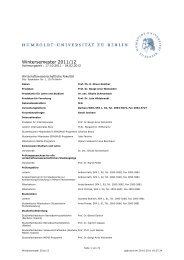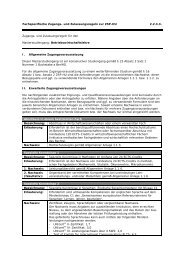Measuring the Effects of a Shock to Monetary Policy - Humboldt ...
Measuring the Effects of a Shock to Monetary Policy - Humboldt ...
Measuring the Effects of a Shock to Monetary Policy - Humboldt ...
You also want an ePaper? Increase the reach of your titles
YUMPU automatically turns print PDFs into web optimized ePapers that Google loves.
Bayesian FAVARs with Agnostic Identification 15<br />
limN→∞N −1<br />
N N<br />
|E(eitejt)| < ∞<br />
i=1 j=1<br />
The decision which approach <strong>to</strong> choose will depend on <strong>the</strong> estimation procedure de-<br />
sired <strong>to</strong> apply. The frequentists DPA approach allows for an approximate DFM, <strong>the</strong><br />
Bayesian requires an exact DFM specification. From my perspective, <strong>the</strong> question which<br />
approach ra<strong>the</strong>r <strong>to</strong> pursue has not yet been sufficiently and conclusively enough answered<br />
in <strong>the</strong> literature. BBE provide results for both specifications and estimation approaches.<br />
Based on <strong>the</strong>ir results, which favors <strong>the</strong> classical nonparametric two-step estimation, <strong>the</strong>y<br />
conclude implicitly that <strong>the</strong> approximate specification might be <strong>the</strong> better one. Here<br />
one should be very cautious, because <strong>the</strong> results BBE compare, might not necessarily be<br />
representative enough <strong>to</strong> draw a conclusion w.r.t. <strong>to</strong> <strong>the</strong> model choice. This will become<br />
clear when comparing <strong>the</strong> likelihood based results with <strong>the</strong> two alternative identification<br />
schemes. As <strong>the</strong> results differ qualitatively <strong>the</strong> conclusion based on <strong>the</strong> results becomes<br />
invalid. In <strong>the</strong> section on <strong>the</strong> empirical results I will show, that with reasonable identify-<br />
ing assumptions such as <strong>the</strong> ”agnostic identification” one can get very reasonable results<br />
in an Bayesian framework. This does not give an obvious hint what <strong>the</strong> correct approach<br />
should be, but at least one can conclude that <strong>the</strong> Bayesian approach does not suffer from<br />
<strong>the</strong> structure it imposes on <strong>the</strong> idiosyncratic component. Therefore <strong>the</strong> structure imposed<br />
must not be an unreasonable restriction on <strong>the</strong> model. It remains <strong>to</strong> fur<strong>the</strong>r research on<br />
this specific issue <strong>to</strong> prove conclusively. More precise assumptions <strong>of</strong> DFMs can be found<br />
in <strong>the</strong> section on identification and normalization.


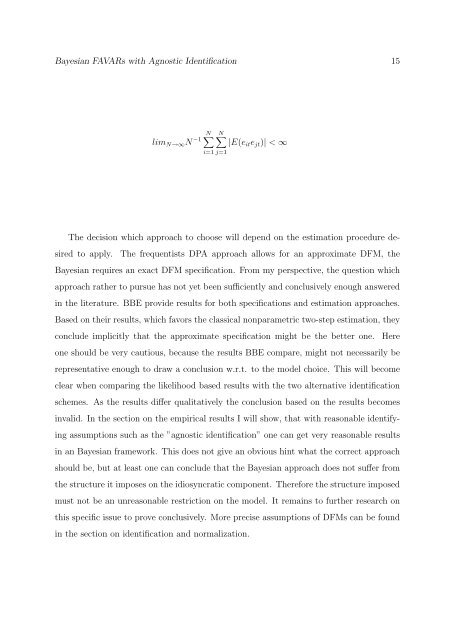

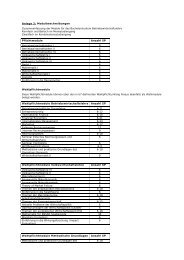

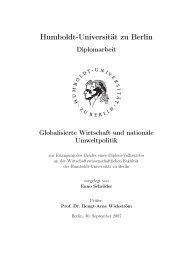
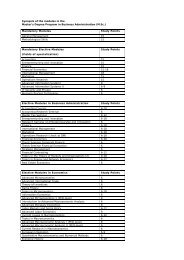
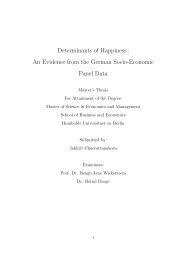
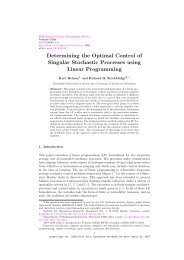
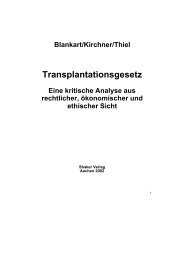
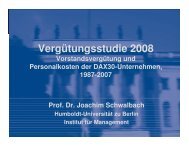

![[Text eingeben] [Text eingeben] Lebenslauf Anna-Maria Schneider](https://img.yumpu.com/16300391/1/184x260/text-eingeben-text-eingeben-lebenslauf-anna-maria-schneider.jpg?quality=85)

